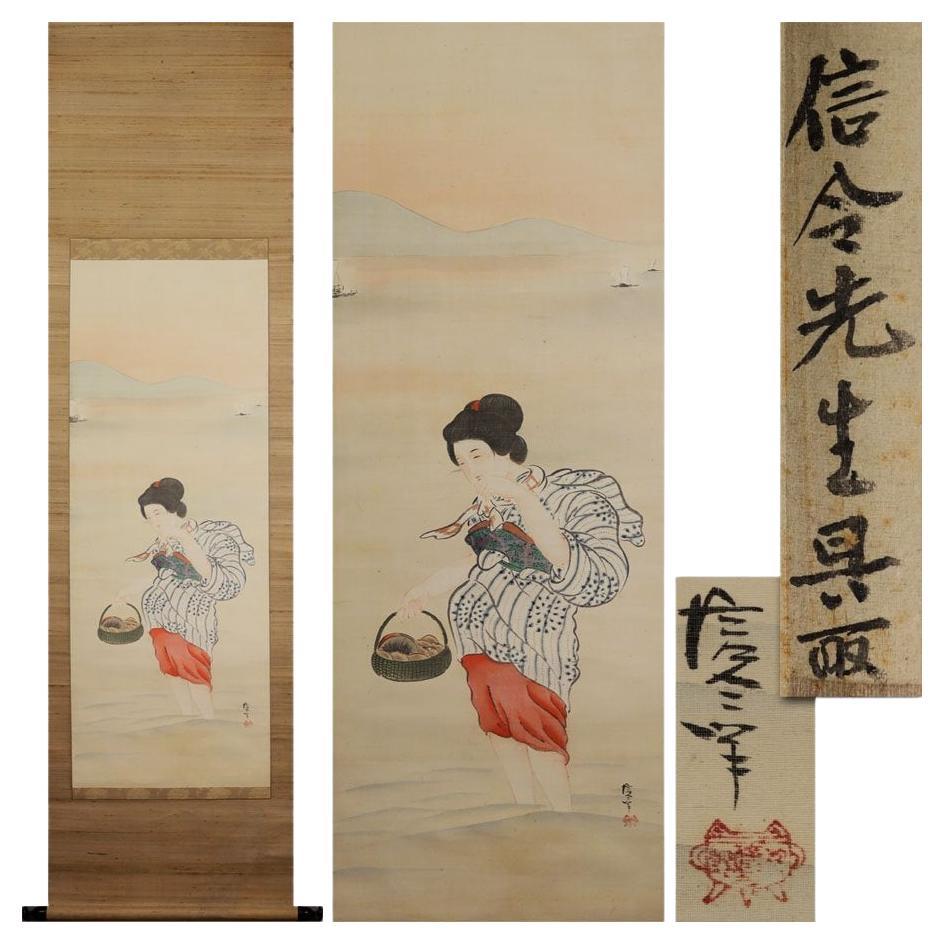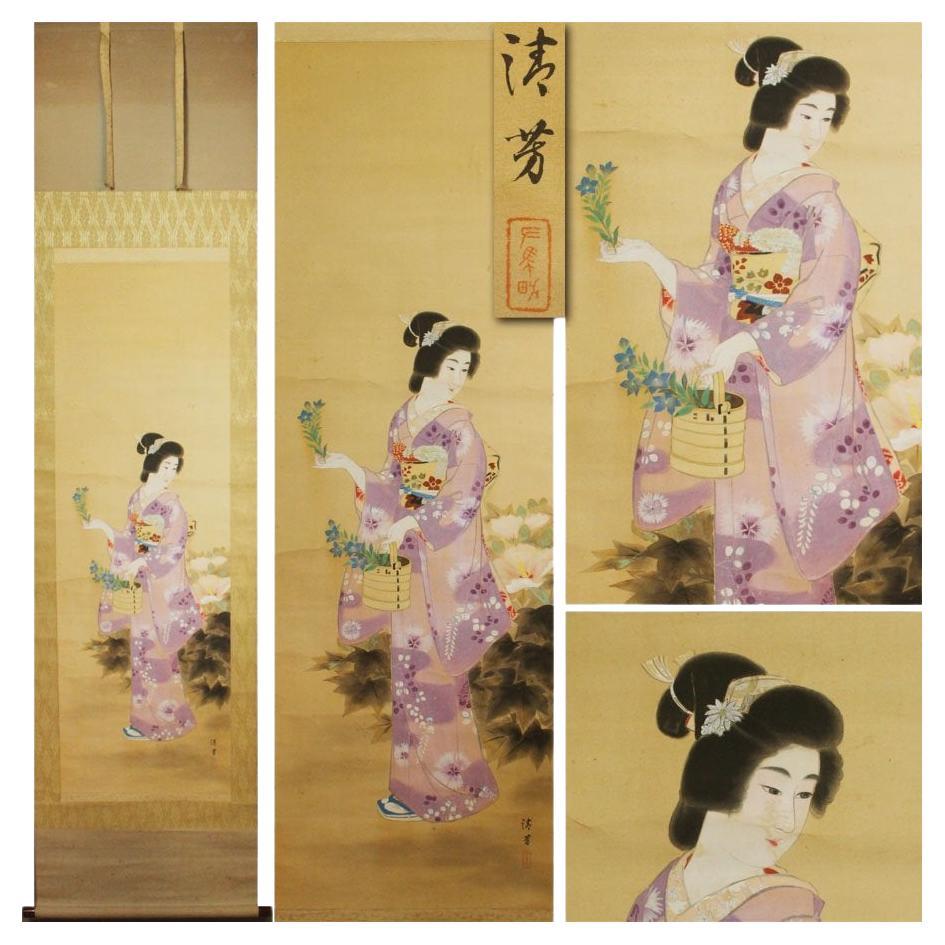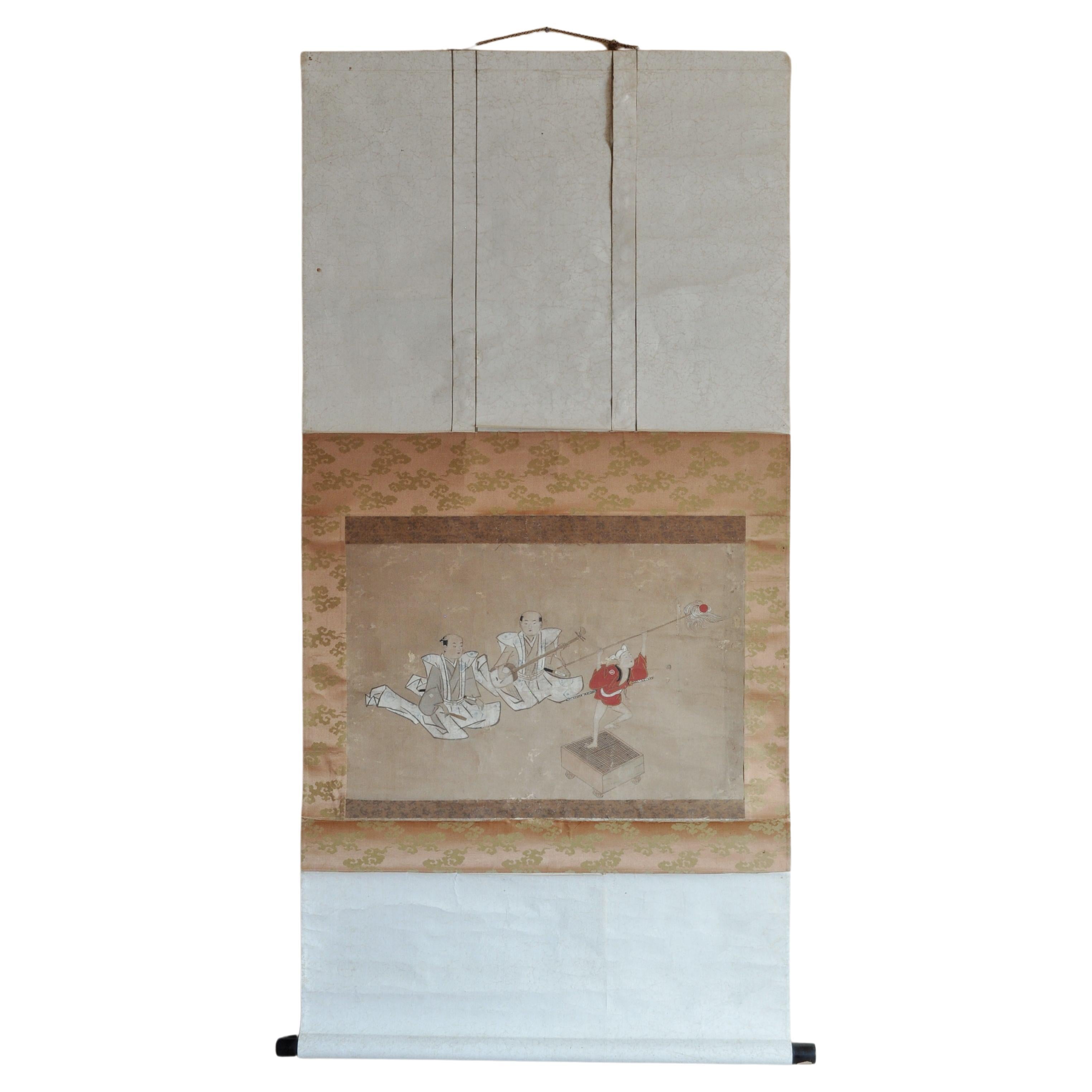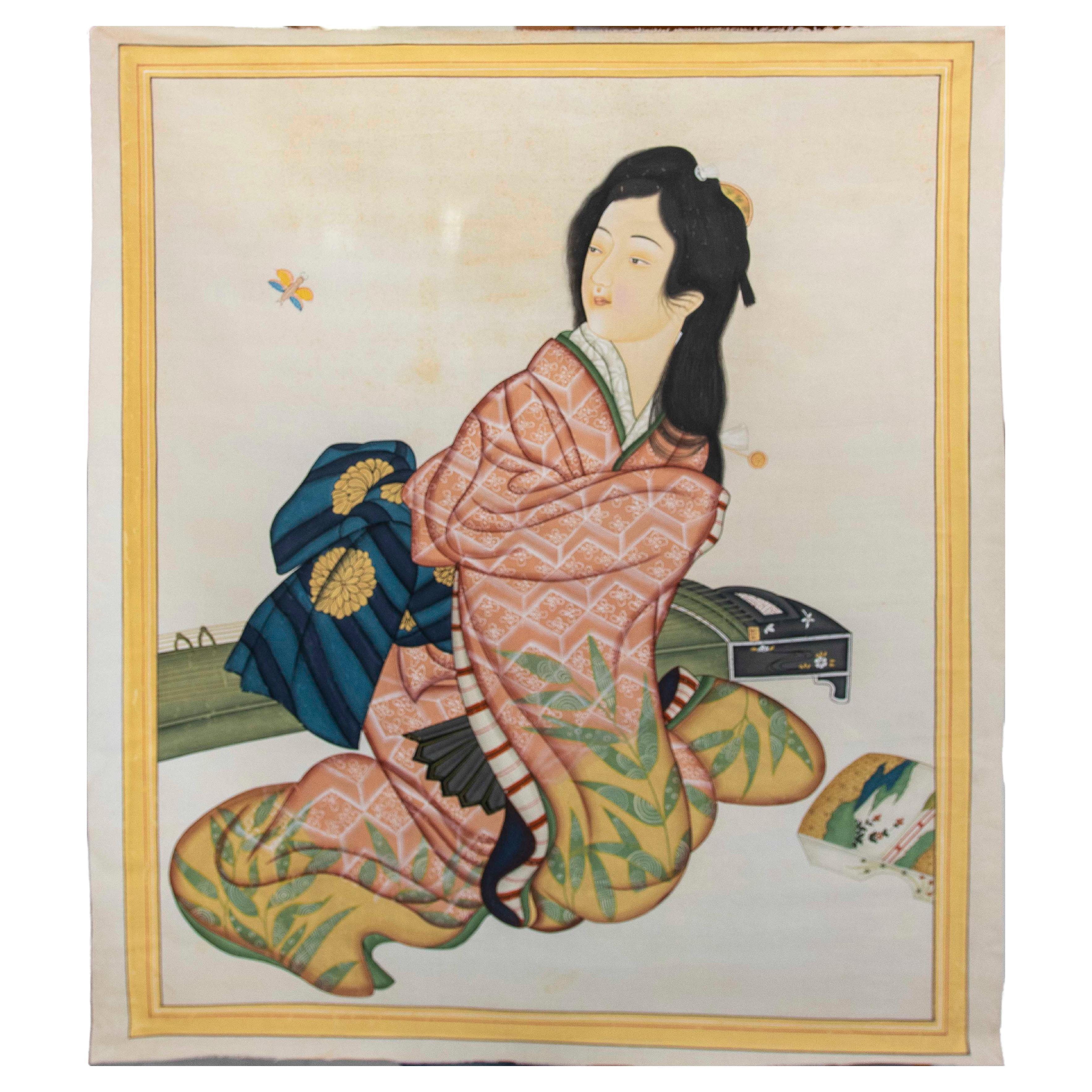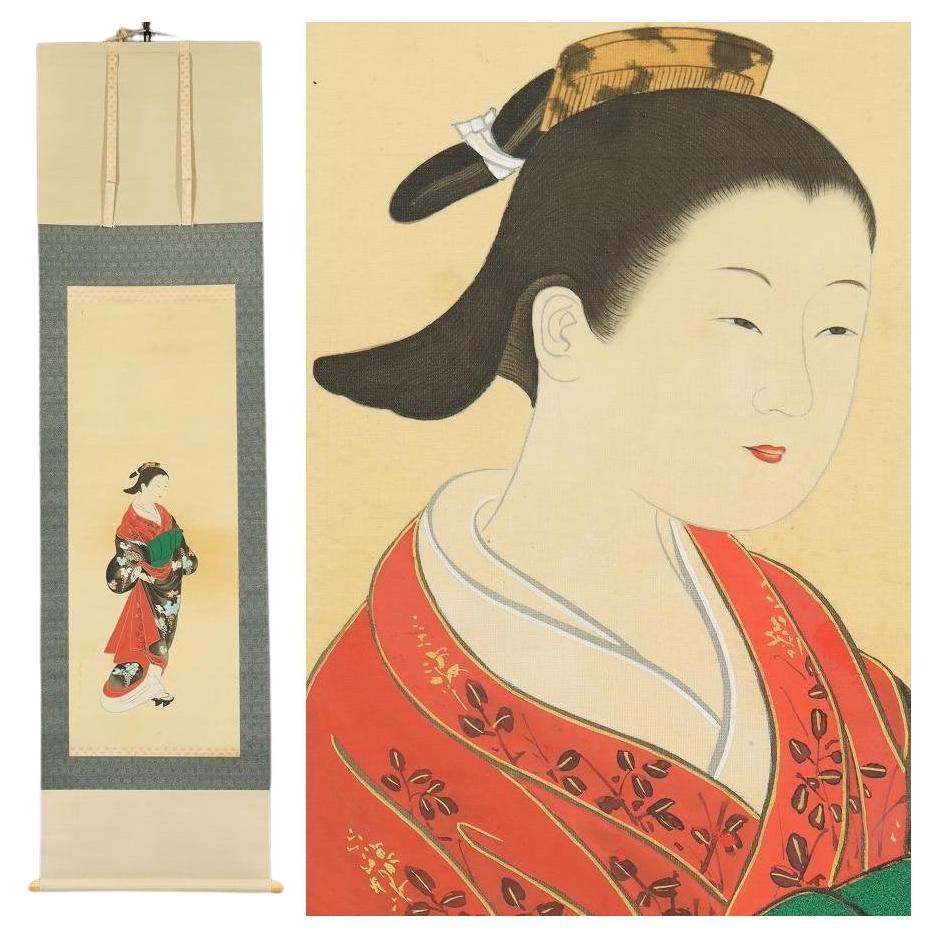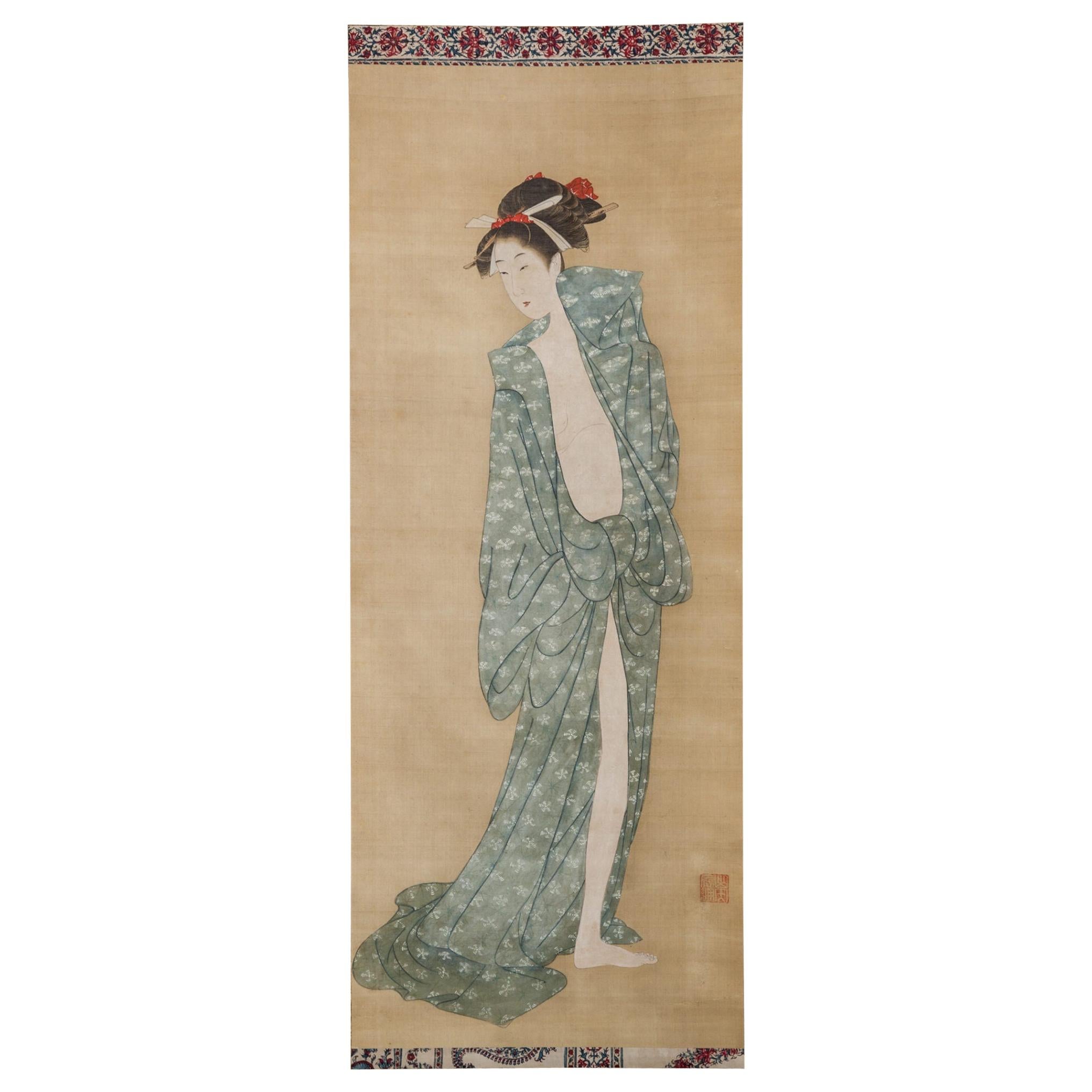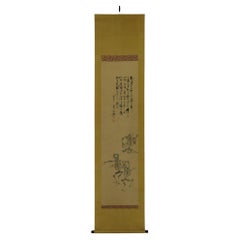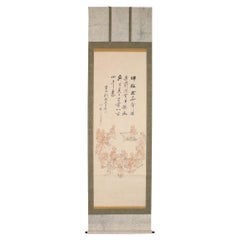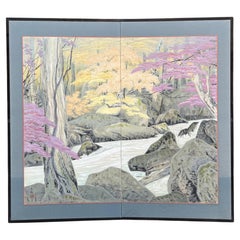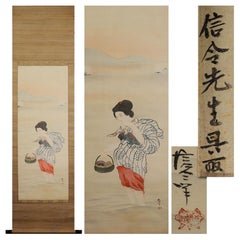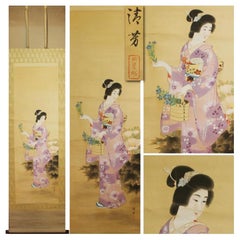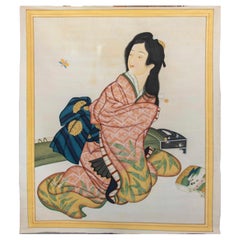Items Similar to Scroll paintingJapan, Woman jumping from the balcony of Kiyomizu-dera Edo period
Want more images or videos?
Request additional images or videos from the seller
1 of 10
Scroll paintingJapan, Woman jumping from the balcony of Kiyomizu-dera Edo period
$4,135.08
£3,099.50
€3,500
CA$5,680.90
A$6,342.19
CHF 3,323.21
MX$77,634.67
NOK 42,204.85
SEK 39,793.82
DKK 26,643.28
Shipping
Retrieving quote...The 1stDibs Promise:
Authenticity Guarantee,
Money-Back Guarantee,
24-Hour Cancellation
About the Item
Japan, Woman jumping from the balcony of Kiyomizu-dera Edo period
Japanese scroll painting – Woman jumping from the balcony of Kiyomizu-dera temple, Edo period
Ink and pigments on paper
Painting dimensions: 125 × 52 cm
Total scroll dimensions: 193 × 65.5 cm
Tomobako
This Japanese scroll painting, created during the Edo period, depicts a woman in a kimono caught in mid-air, just after jumping from the famous balcony of the Kiyomizu-dera temple in Kyoto. With her legs folded, she holds an upturned parasol—a symbol of protection that has become useless. Blindfolded, she surrenders to the void with an expression of calm resignation. Her wide-open kimono reveals her body, partially concealed by her foot in a final gesture of modesty. The composition is exquisite, blending discreet eroticism, dramatic tension, and silent poetry.
This rare subject illustrates the Japanese proverb (Kiyomizu no butai kara tobioriru) – "jump from the Kiyomizu stage," a still-resonant expression meaning "to take a leap of faith" or "to take a decisive risk." Inspired by an ancient folk custom from the Edo period, this belief held that jumping from the balcony of Kiyomizu Temple could grant a wish if one survived the fall. More than 200 people actually jumped, with a high survival rate thanks to the vegetation of the time, until the practice was formally banned in the 19th century.
Very few works depict this theme. A famous print by Suzuki Harunobu, circa 1765, shows a woman in mid-jump, umbrella in hand, but she is not naked and is not wearing a headband. This painting goes further. Through the reversal of the umbrella, the willful blindness, and the tension between unveiling and modesty, it offers a philosophical reading: that of the absurdity of a sincere gift that encounters nothing. It embodies the concept of mitate—a central process in Japanese aesthetics consisting of reinterpreting a classical theme to reveal a more intimate, often melancholic truth.
This rare work from the Edo period poetically and aesthetically questions the solitude of desire, the vulnerability of the offered gesture, and the gaze of the world, which often captures only nudity and not the meaning of the leap. An exceptional piece for collectors of Japanese art or lovers of erotic painting.
- Dimensions:Height: 49.22 in (125 cm)Width: 20.48 in (52 cm)Depth: 1.97 in (5 cm)
- Materials and Techniques:
- Place of Origin:
- Period:1790-1799
- Date of Manufacture:1790
- Condition:Wear consistent with age and use. Some scratches, visible on pictures.
- Seller Location:PARIS, FR
- Reference Number:1stDibs: LU6491244287172
About the Seller
5.0
Recognized Seller
These prestigious sellers are industry leaders and represent the highest echelon for item quality and design.
Established in 1982
1stDibs seller since 2022
6 sales on 1stDibs
- ShippingRetrieving quote...Shipping from: PARIS, France
- Return Policy
Authenticity Guarantee
In the unlikely event there’s an issue with an item’s authenticity, contact us within 1 year for a full refund. DetailsMoney-Back Guarantee
If your item is not as described, is damaged in transit, or does not arrive, contact us within 7 days for a full refund. Details24-Hour Cancellation
You have a 24-hour grace period in which to reconsider your purchase, with no questions asked.Vetted Professional Sellers
Our world-class sellers must adhere to strict standards for service and quality, maintaining the integrity of our listings.Price-Match Guarantee
If you find that a seller listed the same item for a lower price elsewhere, we’ll match it.Trusted Global Delivery
Our best-in-class carrier network provides specialized shipping options worldwide, including custom delivery.More From This Seller
View AllWunderkammer, The Dance of the Skeletons, by Tanomura Chokunyu (1814-1909)
Located in PARIS, FR
The Dance of the Skeletons, by Tanomura Chokunyu (1814-1909)
This Japanese ink and pigment painting on paper, mounted on a scroll with silk borders, depicts the macabre and captivati...
Category
Antique Late 19th Century Art Nouveau Paintings
Materials
Paper
$1,701 Sale Price
20% Off
Rare Japanese painting, Skeletons Studying, Shaku Kaiyin, Japan Meiji Period
Located in PARIS, FR
Skeletons Studying, Shaku Kaiyin, Japan Meiji Period
This ink-on-paper painting, mounted as a scroll with colored paper borders, is titled Skeletons Studying. It portrays a circle of...
Category
Antique Late 19th Century Japanese Paintings and Screens
Materials
Paper
$1,795 Sale Price
20% Off
Two-panel folding screen, Nihonga, Hirai Baisen (1889–1969), early Shōwa era (19
Located in PARIS, FR
Two-panel folding screen, Nihonga, Hirai Baisen (1889–1969), early Shōwa era (1940s)
This two-panel screen is signed by Hirai Baisen (1889–1969), a major Nihonga painter who is only...
Category
20th Century Japanese Paintings and Screens
Materials
Paper
Woman with a Basket of Flowers - Kakuoka Akimitsu, Japan 1930-40
Located in PARIS, FR
Woman with a Basket of Flowers - Kakuoka Akimitsu, Japan 1930-40
Woman with a Basket of Flowers, Kakuoka Akimitsu, Carved Wood, Japan circa 1930-40
This majestic sculpture, carved fr...
Category
Vintage 1930s Japanese Figurative Sculptures
Materials
Softwood
Ohashi Suiseki, Resting tiger, Japanese watercolor on silk, Japan circa 1900
Located in PARIS, FR
Ohashi Suiseki, Resting tiger, watercolor on silk, circa 1900
Midori Ohashi (Ohashi Suiseki, April 1865 -August 31, 1945 ) is a Japanese painter who was...
Category
Antique Late 19th Century Japanese Paintings
Materials
Silk
$2,117 Sale Price
28% Off
Screen Calligraphy, Risking One’s Life Here and There – Sakae Umezu (1926-2013)
Located in PARIS, FR
Screen Calligraphy, Risking One’s Life Here and There – Sakae Umezu (1926-2013)
This two-panel folding screen, created by Sakae Umezu, is a powerful and expressive calligraphic work....
Category
Late 20th Century Japanese Screens and Room Dividers
Materials
Paper
You May Also Like
Japanese Nihonga Painting 19th Meiji Scroll Ukiyo-E Lady picking Clams
Located in Amsterdam, Noord Holland
Product Description This piece depicts a beautiful woman with her skirts
rolled up as she hunts for clams on a shallow shore , giving it an indescribably impressive expression....
Category
Antique 19th Century Edo Paintings
Materials
Silk
$1,699 Sale Price
20% Off
Japanese Nihonga Painting 20th Showa/Taisho Scroll Ukiyo-E Beautifull Lady
Located in Amsterdam, Noord Holland
[Kiyoshi Shimizu]
Born in Tokyo in 1909, Kiyoshi Shimizu was a Japanese painter active during the early Showa period. Residing in Adachi Ward, Tokyo, he apprenticed under Yokoo Yosh...
Category
20th Century Taisho Paintings
Materials
Silk
$1,699 Sale Price
20% Off
19th century Edo period's Hanging scroll Samurai players and child dancer
Located in Chiba, JP
Description - Hanging scroll with quite a surreal scene of the music and dance performance with two seated samurais and a child actor on a go-game-board who plays a role of dancing s...
Category
Antique Mid-19th Century Japanese Japonisme Paintings and Screens
Materials
Paper
Canvas Painting of Japanese Character with Dress and Musical Instrument
Located in Marbella, ES
Canvas Painting of Japanese Character with Dress and Musical Instrument
Category
Late 20th Century Asian Paintings
Materials
Fabric
Japanese Nihonga Painting 19th Meiji Scroll Ukiyo-E Beautifull Lady
Located in Amsterdam, Noord Holland
◆ Ukiyo-e ◆ Beautiful woman painting ◆ Japanese painting ◆ Hand-painted painting ◆ Silk ◆ Hanging scroll ◆
This work is drawn by hand and on...
Category
Antique 19th Century Edo Paintings
Materials
Silk
$1,699 Sale Price
20% Off
Early 19th Century Japanese Scroll Bijin after the Bath in Summer
Located in Hudson, NY
Early 19th century Japanese Scroll: Bijin after the bath in summer. Painted in pigments on silk. Signature reads: Yamauchi Sentsu.
Japan,...
Category
Antique Early 19th Century Japanese Edo Paintings and Screens
Materials
Silk, Wood
More Ways To Browse
Ink Scroll
Japanese Parasol
Antique Japanese Umbrella
Antique Japanese Parasol
Gilded Italian Wall Brackets
Gold Grandfather Clock
Hand Hooked Tapestry
Heinrich Bavaria
Murano Glass Pear
Murano Pear
Narrow Glass Display Cabinet
New Bedford Antique
Oak Altar
Old Vintage Dinner Plates
Olive Dish
Painted Demilune Cabinet
Painted Miniatures Dog
Palm Tree Glass Table
